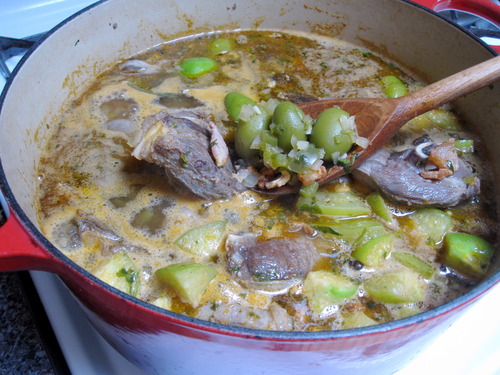Today’s recipe is for a rich and flavorful braised goat stew. Goat is certainly not a dinner mainstay in the U.S., but it plays a major role in the cuisines of many countries the world over including Mexico, Europe, and the Caribbean.
Goats are known for being a little nuts – they like to climb things (other animals included) and they’ll try and eat almost anything (see photo of a goat attempting to eat my windbreaker below). But before you decide that eating a goat is uncivilized or the the meat is “too gamey”, let me remind you that feedlot meat is no substitution, ethically nor flavor-wise, for any pasture-raised animal.
I find it depressing that as a nation we tend to eat a lot of really bland food. Boneless, skinless chicken breasts, American cheese, and feedlot beef come to mind. To some of us, foods like lamb, liver, and traditionally aged cheeses have a reputation of being too rich or even unhealthy, but that couldn’t be further from the truth. Not only are these foods incredibly flavorful when compared to their industrially produced counterparts, they are also healing to the body. The milk, fat, organs, and connective tissue from animals that eat a natural diet is full of beneficial minerals and many other compounds that are difficult to get from other sources in our diet.
The last several decades have been dominated by mass-produced foods that have less flavor as well as reduced nutritional value. The widely held belief that corn-fed beef is more delicious than pastured beef is one example of the the “dumbing down” of our collective tastes due to the influx of low-quality food to our society. If you’re not yet on board with naturally-raised meats, do yourself a favor and drive I-5 through Northern California and get a whiff of the Harris Ranch feedlot operation. I guarantee you, you won’t want to eat a burger without knowing where it came from for a long time.
Next time you visit your Farmer’s Market, talk to your farmer. Buy what’s good, fresh, and in season, and ask about a CSA or meatshare, both of which will save you money and make preparing a dinner from scratch much easier to pull off.
If you’re here in Chicago, think about contacting my hardworking farmer, Paul, or visiting Mint Creek Farm at the Green City or Logan Square Farmer’s Markets. Both raise goats (and lots of other great things) in an ethical a manner as is possible. Remember, every dollar you spend on food is a vote for a sustainable (or non-sustainable) food system.
Latin-Caribbean Goat Stew:
*serves 6 – 8*
4 slices best quality, thick cut bacon, sliced into lardons
3 # bone in goat, cut into large pieces, or 2 # boneless chunks of goat, as fatty as possible (shanks, shoulder, or neck). Beef short rIbs would be a great substitute.
sea salt
1 medium white onion, finely chopped
1 green bell pepper, finely chopped
6 large cloves garlic, minced
1 bunch cilantro stems, chopped (save the leaves for garnish)
1 Tbsp. tomato paste
5 – 6 tomatillos, quartered (or substitute 1 C. diced tomatoes, canned or fresh)
2 bay leaves
5 or 6 allspice berries, whole
6 C. water
12 – 18 green olives, whatever variety you like
In a large dutch oven over medium heat, render the bacon until crispy. Remove it from the pan with a slotted spoon, leaving all of the fat behind. Season the goat pieces liberally with salt and sear in 2 or 3 batches in the bacon fat, until just browned on the outside. Transfer to a plate and set aside.
In the same pan, saute the sofrito (onion, pepper, garlic, and cilantro stems), stirring often, until the liquid cooks away and the vegetables start to stick to the bottom of the pan, about 5 minutes. Add the tomato paste and stir, continuing to cook for another minute to allow for a little more caramelization. Add the tomatillos, bay leaves, and allspice and place the goat with all of its juices back into the pan. Pour over the water and stir to deglaze the pan. Add a few more very generous pinches of salt and return the bacon to the pan. Cover the stew with a lid and increase the heat to high to bring to a boil.
Once the stew is boiling, reduce the heat to a moderate simmer and braise the goat for 4 hours, covered, checking on it once an hour to be sure it is bubbling and to give it a quick stir (boneless goat will likely be done in closer to 3 hours).
Allow the stew to cool slightly and taste for seasoning. Remove the bones if necessary, being sure to scoop out any marrow that remains inside them and return it to the pot. Serve the goat stew over potatoes, rice, polenta, or with tortillas, and garnish with the cilantro leaves.




 RSS - Posts
RSS - Posts